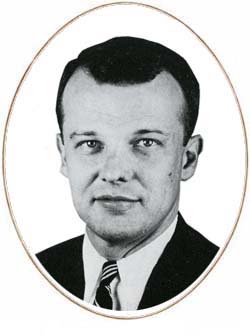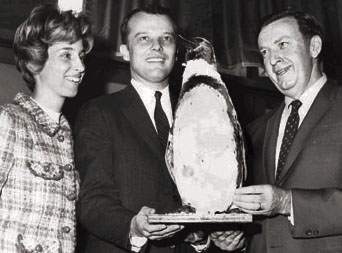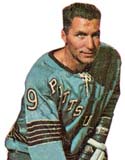FAST FACTS
• In June 1966, Les Binkley became the first player signed by the Penguins.
• Other original investors in the Pittsburgh Hockey Club:
Russell Byers
Robert J. Dodds
W.D. George III
H.J. Heinz III
Art Rooney Sr.
Clint Childs
Charles Cross
Richard Frame
Ira Gordon
Toby Hillard
Henry Hillman
Jerome B. Lieber
Charles Lockhart
Charles Muse
Thomas Nimick
Richard M. Scaife
William Snyder IV
William Standish IV
George Wyckoff
The NHL held an expansion draft on June 6, 1967. The Penguins selected these players from Original Six teams:
1. Joe Daley (G) Detroit
2. Roy Edwards?(G) Chicago
3. Earl Ingarfield (C) NY
4. Al MacNeil (D) NY
5. Larry Jeffrey (LW) Toronto
6. Ab McDonald (LW) Detroit
7. Leo Boivin(D) Detroit
8. Noel Price (D) Montreal
9. Keith McCreary (RW) Mon.
10. Ken Schinkel (RW) NY
11. Bob Dillabough(C) BOS
12. Art Stratton(C) Chicago
13. Val Fonteyne(LW) Detroit
14. Jeannot Gilbert(C) Boston
15. Tom McCarthy (LW) Montreal
16. Billy Dea (LW) Chicago
17. Bob Rivard(C) Montreal
18. Mel Pearson (LW) Chicago
19. Andy Bathgate (RW) Detroit
20. Les Hunt (D) New York
Click on the contract below to see the details and to advance to the next section.
We thought about keeping Hornets nickname, but we weren’t sure that an NHL expansion team could deliver for the loyal locals.
JACK RILEY, the first general manager of the Penguins on the choices of naming the new NHL team
Sen. Jack McGregor
Architect of the Penguins Franchise; Brought NHL Back to Pittsburgh
The Pittsburgh Penguins travelled a long, rocky road to become a National Hockey League expansion team when the league announced plans to double in size to 12 teams.
 It seems fitting that the franchise was born on a stretch of highway that has long held the reputation for being one of America’s roughest roads.
It seems fitting that the franchise was born on a stretch of highway that has long held the reputation for being one of America’s roughest roads.
In the spring of 1965, somewhere between Pennsylvania Turnpike exits 10 & 17, the Pittsburgh Penguins started on a journey that has lasted more than 40 years.
Pennsylvania State Senator Jack McGregor travelled along the turnpike to Harrisburg with a law school classmate, Peter Block, who was a huge hockey fan. “He complained that Pittsburgh had not reached its potential as a sports town,” McGregor recalled in Conversations with Jack McGregor. The NHL planned to expand, and the two men assembled a strategy to bring the NHL back to Pittsburgh after a 35-year absence. Pittsburgh had an NHL team, the Pirates, here from 1925 to 1930, before the stock market crash of 1929 dried up the local economy.
McGregor thought of ways to lobby some of his campaign contributors who were sports fans, and community leaders to help in “leveraging major league hockey as an urban renewal tool for Pittsburgh.”
Block would gather the hockey expertise and shake the NHL tree for any tidbits of information to construct a strategy to land a team in the Steel City.
McGregor lined-up a list of heavy hitters in the Pittsburgh financial world. (See list at right)
McGregor and Block learned the NHL’s expansion plan was centered on geography and that the league wanted to add two teams in the West, two in the Midwest and two in the East. Oakland and Los Angeles emerged as winners in the West; in the Midwest, St. Louis and Minneapolis emerged; and in the East it was to be Philadelphia and one other team. “Our closest competition was Buffalo. The Buffalo group went all out to pick off the sixth franchise,” McGregor said. “Two half brothers Bruce Norris, owner of the Detroit Red Wings, and Jim Norris, owner of the Chicago Black Hawks “two of the total of six votes selecting expansion cities and ownership groups
“ began leaning toward Buffalo.”
It was really impossible for McGregor and Block to predict what impact the Norris brothers had in terms of convincing the owners of the Boston Bruins, New York Rangers, Montreal Canadiens and Toronto Maple Leafs to vote for Buffalo.
McGregor didn’t want to risk losing the franchise and enlisted the help of Steelers owner Art Rooney to sway the Norris brothers’ vote. Rooney was a major contributor to McGregor’s political career and agreed to discuss the Pittsburgh group with the Norris brothers who had mutual friends in the horse racing industry.
McGregor said that Rooney leaned hard on the Norris brothers to support the Pittsburgh franchise. McGregor recalls: “I’ll never forget Art calling each from his New York City hotel room, in my presence. He said to each: ‘You owe this to me. You cannot put Buffalo ahead of Pittsburgh. It would be personally embarrassing to me if you did.’ ”
The call paid off for Pittsburgh as both Norris brothers, Bill Jennings (Rangers) and David Molson (Canadiens) selected Pittsburgh as the sixth expansion team. On February 9, 1966, The National Hockey League granted a franchise to Pittsburgh.
 As part of a public relations blitz, the Stanley Cup arrived at the Pittsburgh airport in March 1966. It was the first time the oldest trophy in North America had come to the Steel City.
As part of a public relations blitz, the Stanley Cup arrived at the Pittsburgh airport in March 1966. It was the first time the oldest trophy in North America had come to the Steel City.
“We paraded the Stanley Cup around town for two days. I was reelected in November 1966 and in October 1967 the Pittsburgh Penguins commenced play in the NHL,” McGregor beamed.
The six new teams paid $2.5 million each for entry to the NHL. The Penguins infused another $750,000 for start-up costs and the Civic Arena’s capacity was boosted from 10,732 to 12,500 to meet the NHL requirements for expansion and also paid an indemnification bill to settle with Bruce Norris, owner of the Detroit Red Wings that held a minor league team in Pittsburgh, the Hornets.
McGregor was named president and chief executive officer by the investor group, and he represented Pittsburgh on the NHL’s Board of Governors. McGregor and Block each owned 12.5 percent of the team.
The nickname seemed like a natural choice to the owner’s wife, Carol McGregor (at left in photo below). Since the team would play in the arena that locals called “The Igloo.”
McGregor hired Jack Riley (at right in photo below) as the first general manager of the team. Riley started signing free agents and began preparation for the expansion draft on June 6, 1967 in Montreal. McGregor refused to meddle in the hockey operations – with one exception.
“Going into the 17th round (of the expansion draft) I noticed that Andy Bathgate, the fading superstar of the New York Rangers, was still available. He was expensive, another reason why he had not been selected. But I felt he had a year or two left in him and should be worth the investment,” said McGregor.
“I told Jack Reilly, our general manager, ‘Let’s go for Andy Bathgate.’ ”
Riley objected: “He’s going to be pricey ($75,000) and how could we do that to the Rangers? He’s one of their marquee players.”
“I said let me worry about the cost and as for the Rangers I explained that Bill Jennings has become a good friend and a beer afterwards should smooth things over. I felt Bill wouldn’t mind losing old blades for new skaters,” McGregor said.
With great reluctance, Reilly announced to those gathered in Montreal’s Queen Elizabeth Hotel, “Pittsburgh drafts Andy Bathgate.” The room, filled with more than 1,000 avid hockey fans and reporters, was electrified. “It was the buzz of the draft. I went straight to Bill Jennings after the draft and he said, ‘You don’t have to explain or apologize. I thought it was a smart move.’ I got lucky it didn’t even cost me a beer,” said McGregor.
Just six months after the Pittsburgh Hornets ended their 26-year run by winning the American Hockey League’s Calder Cup, the Penguins would play their first game.
 About two hours after Clarence Campbell and McGregor jointly dropped the ceremonial first puck of the Penguins opening home game against the Canadiens on October 11, 1967, Andy Bathgate beat Montreal’s Rogie Vachon at 7:06 of the third period. It was Pittsburgh’s first NHL goal in 37 years – when James ‘Bud’ Jarvis scored the last goal for the Pittsburgh Pirates at the Duquesne Gardens. McGregor had the opening faceoff puck bronzed with the Penguins logo on it and still uses it today as a paperweight.
About two hours after Clarence Campbell and McGregor jointly dropped the ceremonial first puck of the Penguins opening home game against the Canadiens on October 11, 1967, Andy Bathgate beat Montreal’s Rogie Vachon at 7:06 of the third period. It was Pittsburgh’s first NHL goal in 37 years – when James ‘Bud’ Jarvis scored the last goal for the Pittsburgh Pirates at the Duquesne Gardens. McGregor had the opening faceoff puck bronzed with the Penguins logo on it and still uses it today as a paperweight.
Bathgate (LEFT) led the Penguins and the Western division in scoring with 59 points (20G+39A) during the team’s inaugural season. The Penguins were 27-34-13 that year.
The second year was a little bumpier on the ice and went 20-45-11, and the team finances never really seemed to escalate.
By the third year, the investors were “tapped out” after having invested in a pro soccer team, the Pittsburgh Phantoms.
With the strong backing of John Heinz and the Mellons, opposed vigorously by Henry Hillman and
others, the Penguins were sold to the Donald Parsons Group from Michigan.
“Henry (Hillman), as usual, turned out to be right. Parsons, while a good guy, was not strong enough financially to be a long-term player. The Penguins had to be sold by Parsons in another short three years,” lamented McGregor.
